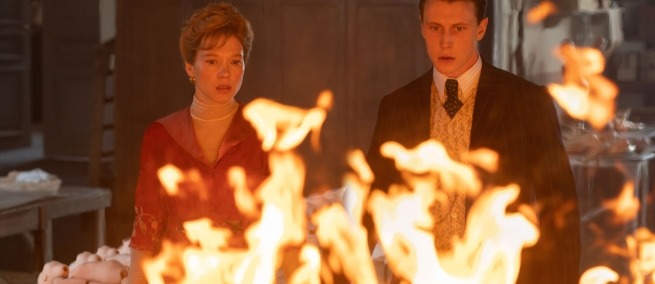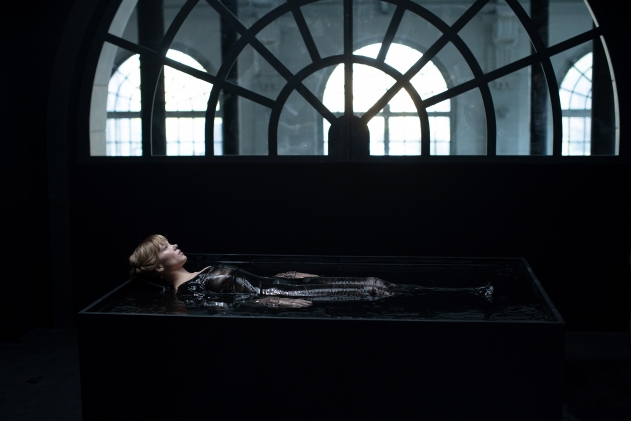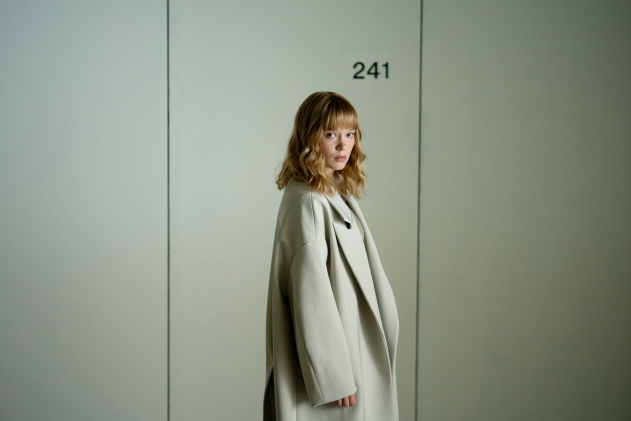
Bertrand Bonello (NOCTURAMA)’s tripart feature THE BEAST is set in 1910, 2014, and 2044. Léa Seydoux stars as Gabrielle who, in 2044, undergoes a procedure mandated by the artificial intelligence that controls society which aims to erase her past-life romances with Louis (George MacKay). The film had its world premiere at the 2023 Venice International Film Festival and is being distributed by Sideshow and Janus Films. It is currently in theaters. We spoke with Bonello about his fears about technology and AI, the sci-fi genre, his shooting style, and working with the actors.
Science & Film: When you were writing this film, I'm sure that AI didn't have as big a place in the conversation as it does now. What was your thinking about it at the time?
Bertrand Bonello: It is true that when I started writing the film, like five or six years ago, I couldn't have imagined that the year the film will be shown, in Venice and Toronto, fall 2023, AI would be the center of so many worries, so many discussions—and if we talk about cinema, such a huge strike, and so many negotiations. I thought it would be like, in 10 years, not now. So of course, that makes the film much more contemporary. But one of the subjects of the film is the relationship between humanity and technology. It's true that it's something that fears me a lot.
The present of the film is 2044, so it's the future. I realized that when you make a science fiction film, because in a way, [THE BEAST] is also a science fiction film, inventing the future is a way of talking about your fear of the present. The relationship between humanity and technology is one of my fears. Technology is a tool, and human beings must be the master of the tool. If he's not, if the tool is the master of humanity, I think it's the beginning of the end. Even in the scenes in Los Angeles, which is set in 2014, you see Léa Seydoux very connected with her computer. You see George MacKay on his iPhone and stuff like that. But what do you see before you? You see two people who are very, very lonely. I think it's something very, very strong in today's world, loneliness. I have in 2014 a character that we can call an INCEL, and technology is part of this loneliness. And now with AI, of course, it's like three steps higher. There are some wonderful things to do with it, too, for research, for science, for medicine. But last year, we could see that the whole world was very scared, because it also has to go with some ethical, moral, political decisions and worries. And that's where you don't know where the limit is.

Léa Seydoux in THE BEAST. Courtesy of Janus Films.
S&F: Do you see do you see emotions as the thing that separates humans from machines, or is it intelligence? I'm thinking of the premise of THE BEAST in which human emotions are forbidden.
BB: We have to define what intelligence is, it's not the same for a lot of people. For a lot of people, having a lot of knowledge is a kind of intelligence, which it is not, it's just knowledge. No one can have as much knowledge as a machine now, you know. But, sensibility is something very human. Now, machines are not able to have sensibility, but they might be able to fake sensibility—reproduce our sensibility. For example, I started to play, like everyone, with chatGPT. I said, write me a script Bertrand Bonello would write. Five seconds after that, I had a script. Me, it takes me like five years. I don't say the script is good, but it's not stupid. There are a lot of ideas. Of course, I won't use that. But it's always a little freaky, you know, because we know that in three years it's going to be million times more powerful, and more powerful might be like, having more possibilities, even to introduce some poetry, even to introduce some weakness, because we're made of strength and weakness. Maybe machines will introduce weakness in their thinking,
S&F: You spoke about the feeling of loneliness in THE BEAST, especially when it comes to scenes of people with their devices. How did you work with your DP to evoke that feeling?
BB: It's a DP I've done so many films with, so we know each other very well, that's a good thing, because we go very quickly. Usually what we do is during the prep we send each other some ideas and a lot of images. In this precise case, you have three periods: 1910, 2014, and 2044. So, we tried to find something very specific for each. In 1910, we decided to shoot on 35mm, because we needed something very central for this love story. We wanted to really feel the skins and feel the clothes and feel the faces and 35mm was the only solution. Then, for 2014 and 2044, the sharpness and the coldness of digital was perfect. We decided to shoot the present of the film, 2044, in a square ratio, 1:3;3, as a way to say, there is no more space. The characters are very alone. And then when you go back to the past, you go back to a 1:8:5 ratio, something wider, like the past was a refuge. Like if the past was going to the movies. And then, of course, it becomes more precise with each scene, how to shoot a girl alone in a house facing the computer, how to make this interesting? How to do the fire scene, the underwater scene, small technical questions. But basically, one of the main questions was, how to make one film and not three with these very, very specific atmospheres.
S&F: In the scriptwriting process, did you consult with any scientists, or read any books that were particularly informative?
BB: Yes, I worked with a specialist in AI. That's why I was quite aware of the many dangers. But as I told you, I didn't know it [the technology] would [develop] so quickly. I don't want to say that technologies are the devil, you know, it's not like it was better before. It's just, it asks new questions, and basically, political questions. I mean, with a hammer, you can put a painting on the wall, but you can also kill someone—it depends what you do with the tool. And that's what is scary.
S&F: So, did you intend the film to be a sort of warning?
BB: I don't want to have any messages, you know? I prefer films that give questions, much more than films that give answers. And I think the film opens with many, many questions. Intimate and collective.

Léa Seydoux in THE BEAST. Courtesy of Janus Films.
S&F: I think that's something the sci-fi genre can be particularly good at—posing those provocative questions. What is your relationship to the genre?
BB: I don't have much relationship with science fiction. It's a big lack I have. I don't read much, I don't see many films. But when I was working on this film, I decided to go to science fiction because it allows you to invent concepts, and that's fantastic. Like in philosophy. I invented two concepts. The first one was that humanity has failed and AI has taken the power and solved all the problems, and there is a price to pay. And the other one, which is more about my main character, about Gabrielle, she has this horrible dilemma which is choosing between interesting work and emotions. When you have dilemmas for characters, it's very good to tell a story.
Usually in science fiction, you have two major tracks. One is the hyper technology stuff. The other one is post-apocalyptic. My future is like tomorrow, it's in 20 years. I took the world basically as it is, and I took away some stuff. There are no more cars, no more internet, no more commercials, no more relationships between people.
S&F: Why did you think of Léa for the role? Did you write Gabrielle thinking of her?
BB: Very quickly during the writing I was thinking about Léa, who I know quite well—she's been in two of my previous films, smaller parts. For me, she's the only French actress that can be in the three [time] periods. She's timeless, she's ageless, at the same time she's very modern, at the same she can be in any period. The second reason is, there is something very mysterious in her, even if she gives a lot in terms of emotion on the screen. Working with her, she's particular. She doesn't want to prepare herself, she doesn't want to discuss scenes before the shoot, as if talking or discussing could cut her off from her instincts. So, she arrived on the set not always knowing what we were going to do. She likes to discover the scene while she's shooting it. So, I'll just say the few words that would ring a bell, and it's her way to abandon herself.
S&F: Can you talk about the use of green screen?
BB: It was the first scene I wrote, the prologue, the green screen scene. I knew that I would not move it and that will be in the film at the end. For me, there are three reasons. The first one is that, for everyone in the world, green screen is related to virtuality. So, the audience knows that there is going to be some virtuality in the film. If you open with the 1910 scene, it looks like a period film. If you open with a green screen scene, you know it's going to be weirder than that. So that was the first reason. The second is, I don't know, maybe the scene is two or three minutes, and you have Léa alone in this green ocean totally lost. It's a way to say, the subject of my film, it could be love, it could be fear, but in a way, the subject of my film, it's her—her Gabrielle, and in a way, her, Léa. The third reason is that there is some fiction in this scene. There is a scream, and we talk about the beast and stuff like that, and when you go to the next scene, the one in 1910, which is a long, long, long party scene, you enter in the scene loaded with something.
♦
TOPICS